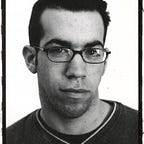What is a “serif” in Hebrew?
When calling a Hebrew typeface a serif or a sans serif, one borrows a typographical term from one script to describe another. This isn’t necessarily a bad thing — Hebrew designers need a way to describe fonts, and “serif” is as ubiquitous a term as in Latin.
For instance, Frank-Rühl is a serif typeface by virtue of the bumps adorning its top strokes. Haim, by contrast, is a sans serif with letterforms composed entirely of base strokes.
Miriam is a monolinear typeface with added short strokes, i.e. the curved bottoms of ל (lamed) and ק (qof). The top strokes of the letters are also defined by the same short curved lines, making it hard to determine whether they are essential base strokes or “serifs”. To settle this ambiguity, Miriam is usually regarded as a slab serif.
What category does Narkis Block fall into? It may appear to be a sans (some even compare it to Helvetica). The letters י (yod) and ו (vav) feature top head strokes, while alef (א), shin (ש) and ayin (ע) appear without any head strokes. Is it a sans or a slab, then? Or maybe a half slab?
David’s elegant strokes hint at a sans, but the triangular features on the tops of ד (dalet), ה (he), ך (final kaf) and several other letters place it in the serif category. The term half serif is also sometimes used, though probably misled. So which is it, serif or sans? At this point, it’s advisable to take a step back and take a system-wide look.
The Hebrew word commonly used to describe a serif is tag, a term from the Jewish Talmud describing stamened decorations adorning the tops of Hebrew letters in the Torah scroll, with intricate rules on how and where to apply them. This makes tag a ritualistic term, not necessarily typographical. Ada Yardeni, a paleographist and type designer, coined the term oketz (sting), meaning “a short stroke added to the basic strokes […] or the projection of a stroke beyond its meeting point with another stroke.” Whether we call this element a tag or oketz, its analogy to the latin serif is inaccurate.
The discussion about the origin of the serif is still ongoing. The most widespread theory is by Edward Catich, who based his study on ancient Roman inscriptions. According to his theory, scribes would end strokes with a slight twist of the brush to avoid an unaesthetic smear. Serifs, born from the flat brush, were afterwards carved in stone, fixing them to the letterforms.
Serifs have materialized in the humanist minuscules of the middle ages in the form of short diagonal strokes, from which they found their way into the early types of the 15th century.
The reason serifs have persevered from early Roman days may be attributed to their typographic function. A line of text is essentially a rhythmic array of strokes in different widths, allowing the eye to scan it quickly for familiar patterns. Each letter holds a different ratio of thicks and thins — for example, the letter O has two thick strokes and two thin strokes, while I has only one thick stroke. The two serifs on its top and bottom help to balance this difference and to create a haromious rhythm: IOIOIOI.
The serif demonstrates a typeface’s contrast: its width marks the thicks and its height marks the thins. In slab serifs, low contrast makes the serifs as thick as the main strokes. In sans serifs, demonstrating the contrast is deemed unnecessary, whether for functional reasons (rhythm is balanced without serifs) or aesthetical (in the case of display fonts).
David’s contrast is based on writing with a broad pen held at a 60º angle from the baseline. The edges of the strokes feature cusped triangular terminals, a shape embodying its thicks and its thins. Therefore, those cusps are like serifs, even though they are a part of the strokes.
In Narkis Block, the selective presence of head strokes provided ambiguity. The answer may be in the typeface’s wide proportions, with head strokes added to the letters that were not wide enough, such as ו (vav) and י (yod). In the already wide letters, there was no need for more width, which is why the head strokes were probably omitted. In this case, the selective addition of head strokes was made to create a rhythm that works better with its wide proportions, in a similar fashion to how serifs are added to the top and the base of an I to create a more consistent rhythm.
Is it correct to describe Hebrew typefaces as “serifs” or “sans serifs”? Unforunately, there is no simple answer. Every adaptation of a Latin system for non-Latin use is an interpretive measure, and has to be taken with a grain of salt.
Hebrew, similarily to Latin, is based on writing with a broad pen and features similar principles of contrast and rhythm; therefore, it may often need elements similar to Latin serifs, but not entirely identical. It’s important to notice the differences and the semblences, and most of all to keep an eye out for fresh examples of Hebrew typography, which most definitely will make writing these kinds of articles easier in the future.
👋🏾 Get to know the people and ideas shaping the products we use every day. Subscribe to Noteworthy — the product & design newsletter written by the Journal team.
